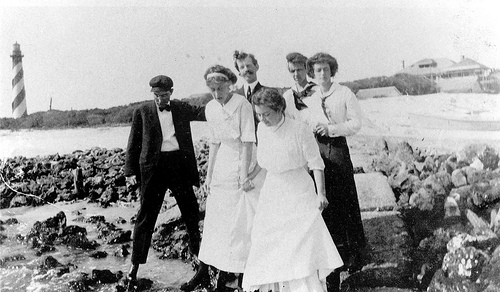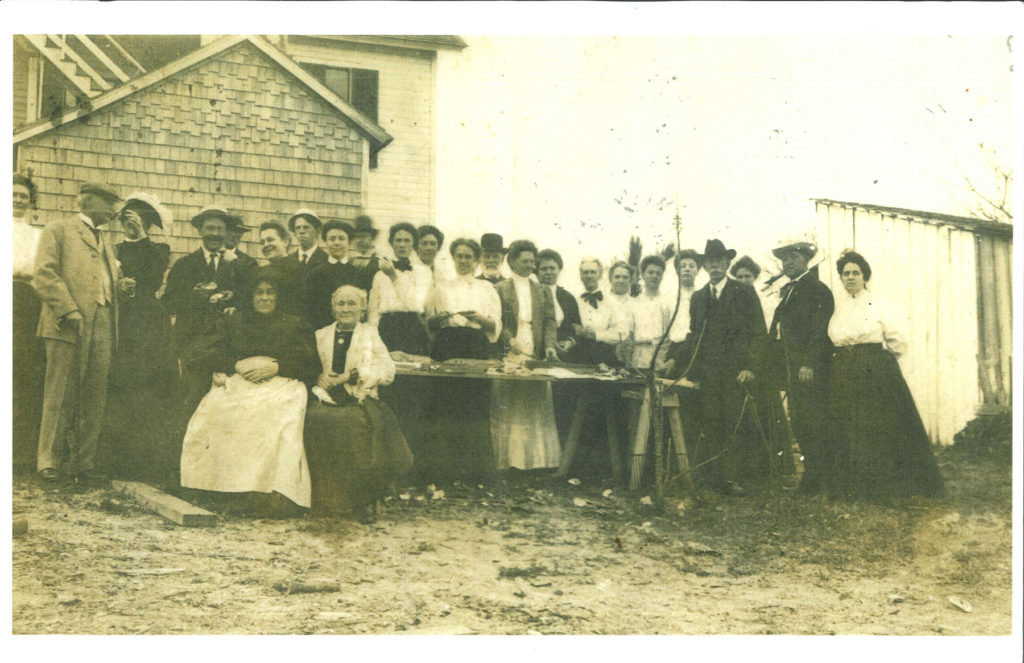By Jay Smith
On June 26, 1916, readers of the St. Augustine Evening Record read an entertaining interview with 68 year old Oregon Dunham offering “very interesting reminiscences” from a man “whose remarkable memory…retained so much of what happened in the earlier days.” Dunham recalled significant events in the Oldest City, including the Civil War and some of the local folklore. “Oregon” was a nickname for Francis Philip Fatio Dunham. His mother, Mary, was the daughter of his namesake, Francis Philip Fatio, who arrived in Florida during the American Revolution. His father, David Ross Dunham, born in New York City, came to Florida to oversee his family’s sugar plantation in New Smyrna. The Dunhams proved to be one of several prominent families in Florida’s history. Interestingly, of all the Lighthouse Keepers, Oregon Dunham held the shortest tenure at the station. On April 1, 1875, William Russell and his family moved out of the tower and delivered the keys to then-Assistant Keeper Dunham. On April 15, Dunham accepted the official appointment as Keeper of the St. Augustine Lighthouse. By November 18, a new Keeper, William Harn, arrived.

Oregon Dunham certainly had the pedigree to position himself into a government job such as the Keeper at St. Augustine. As William Russell discovered, government jobs in St. Augustine often depended less on skill and training than upon connections with the rich and powerful. Dunham’s family connections certainly placed him at the top of the applicant pool. He began working at the light station on October 15, 1874, as the First Assistant Keeper under Keeper Russell. Once he received the appointment as Head Keeper, the Second Assistant Keeper, Philip J. Canova, received a promotion to First Assistant. Canova stayed only a few months and then resigned. In order to fill the vacancy, Second Assistant Daniel Mickler was promoted to First Assistant. Such a personnel change may suggest contentious issues at the station; however, we have no record of what prompted Dunham’s dismissal. Nevertheless, the Keeper’s Log provides some hints to the cause.

A Dunham Family photo courtesy of the St. Augustine Historical
Society Research Library.
Within a few months of Dunham’s appointment as Head Keeper, an accident took place. The tower was literally less than a year old when on June 21, 1875, “a little after two o’clock the weight of the mechanical lamp fell through the receiving well carrying the bottom off of the flange and fell into revolving machinery thereby springing some of the shafts so badly as to prevent the ‘revolving’ of the lens.” Although the extent of the damage is not known, the result was that the light ran only as a fixed light, meaning that the lens did not rotate. Thus, the light station could not display its night mark. The log records that the light was back in operation by June 26, 1875, following a visit by the United States Lampist who “placed [the light] in perfect order.” The log also records that the Captain Inspector, AEK Benham, made two more visits to the light station, once on July 28 and another on August 29. Each visit apparently entailed repairs to the site. On the July 28 visit, the Captain Inspector, in his own hand, wrote in the log, “Written the Principal + assistants are to absent themselves from the station until all work is finished and the light + appurtenances are ready for inspection.” In the Light Station Service, multiple visits from the Lampist hinted at a problem perhaps with the light itself; however, multiples visits by the Inspector General within a few months’ time, meant that something was fundamentally wrong with the way the station was run.
Since the tower was relatively new, the Light House Service was bound to be concerned about the job Keeper Dunham was doing. In fact, on November 18, 1875, a new Keeper named William Harn arrived to take command of the Light Station. Although there is no mention in the Keeper’s Log of the removal of Oregon Dunham, we do know that it took place prior to Harn’s arrival. The Keeper’s Log does not record any major incidents for well over a year after Harn’s arrival and appointment.
What happened to Oregon Dunham? As in the case of William Russell, Dunham remains an elusive figure in historical records. He remained in St. Augustine, and most of the city directories mention him as a gardener. He resided in the home of his mother, Mary Dunham, located on Charlotte Street behind the St. Francis Barracks. She owned two pieces of property: one on Charlotte Street and the other just behind it on south St. George Street facing Maria Sanchez Creek. With the death of his mother, Oregon inherited these two pieces of property. The city directory lists a boarder with a “b” by Oregon’s name until 1890 when he became an owner, marked with an “o.”
Unfortunately there are no additional records mentioning Oregon until December 7, 1911, when he sold the property which he had inherited from his mother. He sold it to his brother, David L. Dunham, for the sum of ten dollars. The warranty deed records only the monetary transaction, not why Oregon sold the land. The next mention of Oregon appears in the article in the St. Augustine Evening Record of June 26, 1916. In September of 1916, Oregon Dunham applied for residence in the Florida Confederate Home in Jacksonville. Created by the Florida Soldiers Home Association in 1888, the facility was a retirement home for Confederate veterans. The Association had purchased ten acres of land along Talleyrand Avenue for the construction of an Italian-styled building with nine rooms. An adjoining home contained two additional rooms. Residents had to furnish proof of their Confederate military service as well as their honorable discharge or parole.
On August 10, 1861, Oregon Dunham, only 14 years old, had enlisted in Company B of the Third Florida Infantry, otherwise known as the St. Augustine Blues. His older brother, David Lewis Dunham, enlisted in Jacksonville with Company H of the Second Florida Infantry. Oregon served for only a short time before his parents pulled him out of service because of his youth and a physical disability. He hired someone of the same age to serve in his place and to answer to “Oregon Dunham.” However, the substitute was discharged on November 2, 1862, in Knoxville, Tennessee. Dunham remained in St. Augustine throughout the war. Refusing to take the oath of loyalty to the Union, he found himself in custody. When the other Confederate supporters in St. Augustine were deported to Confederate lines, the Union commander ordered that Dunham remain in St. Augustine and daily report to the Union Provost Marshall. Dunham detailed his war experiences in his application for a Confederate pension in 1909. Unfortunately, when Dunham filed the paperwork, he used his given name, Francis Philip Fatio Dunham, not Oregon Dunham. The State Board of Pensions denied the request since there were no records filed under his given name. A second application included both names, but met with the same fate since Oregon had used a substitute. Using their connections in state government, the Dunham family requested that Oregon be awarded his pension. Therefore, on June 13, 1913, the Legislature of the State of Florida passed State Bill Number 127 requiring the State Board of Pensions to “accept proofs submitted by the said Oregon Dunham as proofs of service and place his name on the roll of pensioners to whom has been allowed a pension.”
The disability mentioned by Oregon Dunham in his application for a Confederate pension is known as varicocele, the enlargement of the veins in the scrotum (very similar to varicose veins which occur in the legs). The condition can cause a great deal of pain and usually leads to infertility. Even with today’s medical knowledge, the exact cause of the condition is unknown, and there are no known risk factors that contribute to the diagnosis. The common treatment for the condition was surgery; however, it is doubtful that Dunham would have opted for such an invasive procedure. One of the major causes of death during the Civil War was not wounds inflicted upon soldiers but the conditions in field hospitals and operating rooms where infections ran unabated.
Although Oregon Dunham supervised the St. Augustine Light Station for only a short time, his tenure there was historically important. Despite the unfortunate incidents that seem to have cut short his career in the Light Service, Dunham’s service demonstrates that family connections and prominence in the community provided him an opportunity to serve. We must remember that following the Civil War, appointments for most government offices were rarely based around experience. The civil service exam would not determine eligibility for government service until the Pendleton Act of 1883, and even then the number of government positions within the government that required the exam was minimal. Following his time as Keeper, Dunham remained in St. Augustine and was employed as a gardener. More than likely, his disability kept him from pursuing farming or any other physically demanding occupation. He died in 1916 and was buried in St. Augustine’s Evergreen Cemetery with other members of his family. When William Harn arrived in St. Augustine, the Light Service sought a Keeper who could avoid the errors of the former Keeper while bringing stability to the station.

